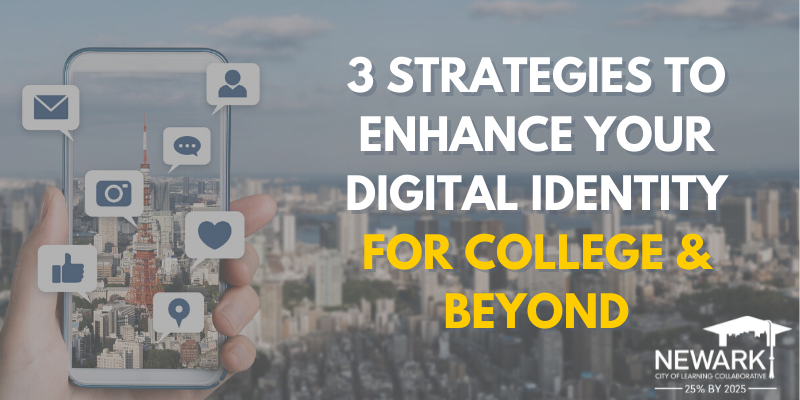
3 Strategies to Enhance Your Digital Identity for College and Beyond

If you’re searching for jobs or applying to schools, chances are: people out there are searching for your information to help make a decision about you.
In this day and age, the internet and social media give others a very wide lens into your life. With this in mind, it’s crucial to keep track of just what information people can discover about you online.
Before you continue, try and Google yourself! Become familiar with what you see, and take note of the results you like, and the things you would like to see added, modified, or removed.
Search engines allow people to find out whatever they want to about you. People might do this to help make judgments about your character, or just to find out more about your identity. Whatever the case may be, nowadays, a digital online identity is something almost everyone has–that almost everyone can search for and see.
Therefore, it must be maintained deliberately and handled with care!
Digital Footprints
You have what is called a “digital footprint” on the internet. Your digital footprint consists of things like the names of your social media accounts, photos and videos that you post, content that you are tagged in, and accounts you interact with online.
Social media activity has the heaviest influence on the modern digital footprint. This is due to the stark rise in–and the mass adoption of–online social networking over the last decade. But also, it means: you need to be cautious about how you behave on social media!
So as an applicant striving to compete for a position, whether at a new company, organization—or a new school, keeping track of your digital footprint is the best way to accurately express and control your digital identity.
Now, it’s true that social media is sometimes a scary space to navigate: There is a major lack of privacy. Nothing you post ever really disappears. People freely publish and share loads of false information. Some platforms steal your attention and leave you incapacitated for hours.
It’s not all bad, though.
The great thing is, you are actually in full control of most of the factors that can positively affect your online identity. Social media sites are a place for people to tell their stories! Users can introduce themselves online, build a network of peers, and show off their skills. So, rest assured, learning how to use social media properly–and to your own advantage–will seriously benefit your personal branding. As a result, it should provide you with better networking opportunities–and thus, better career opportunities.
Below, we have outlined three strategies that can help you best represent who you are using social media.

Developing a Digital Identity
Carefully planning and developing the presentation of your identity is the first step. This is key in letting others know who are and what you can do.
Make sure that you are aware of all the content that ties to your name. As mentioned earlier, Google yourself!
Know what’s out there and start thinking about how you want to represent yourself. Put yourself in the shoes of a hiring manager or admissions counselor, and try to visualize what either of them would want to see in an applicant. Although this might require some research, it’ll set the foundation for you to build a noteworthy digital identity.
When thinking about what’s important information to display to others on the internet, make sure it’s accurate and informative. You might see something that you don’t want others to see online, like an embarrassing photo or post. Or there might exist some kind of misleading information, like a hacked or fake account, misrepresenting your brand and identity. Very fortunately, you can almost always update your privacy settings on the respective platform so unwanted information stops showing up in searches. If this doesn’t work, you can always send an email or chat with their support teams to resolve the matter.
Be sure to purposely engage on social media. Be sure to interact with content and people that you like. Your online habits tend to reflect your character. For example, imagine someone who openly expresses hate towards certain groups of people online. They make rude comments and repost offensive content. Employers will feel that this person will behave the same way within their workspace. They will thus be hesitant to allow this behavior at work or on campus. Make sure your values are reflective of your social media accounts. Know what to publicize, and what to keep private.

Building Your Online Brand and Portfolio
People often switch their accounts to private mode so that fewer people can find them online. There will always be information about you online though. Sometimes, it is even a disadvantage to keep all of your information private.
If you are looking to gain exposure for your skills online, it’s certainly better to keep your posts public. Otherwise, it will feel like trying to be seen after turning yourself invisible! This way, whoever is looking for you online can find what they need to know about you with ease; be it an employer or an admissions office.
Social media is like a canvas where you can display your skills, talent, and reasons people should desire these skills and your talent. After developing your online identity, it is important to use it to convey a story: your story. Nothing much will happen if you only tell people what you do. In order to make an impression, you must display, present, and demonstrate your story as much as you tell it! This means: if you have created some kind of content that exhibits your skills, make a website about yourself! Don’t be afraid to show others your work. Create a portfolio!
Your portfolio can highlight things like your art, writing, services, products, or whatever you want to showcase. A portfolio is your opportunity to show the world what you have offered others, and thus, what you can offer to the world. Look to leaders in your industry and field to gain inspiration on how to go about creating and presenting your portfolio. Although, be sure to stay original, creative, and innovative. Your portfolio should set you apart from your competition. It should not cause you to blend in.

Building Your Network
Okay, you have built your social media identity and have created an online brand for yourself. You made a portfolio that showcases your skills and talents. Now, in order to really spread the word about–well, yourself, it’s time to network!
Most people use social media just to connect with family and friends. Several people fail to realize that the people you need are just a search and a click away. Follow with your influences. Research and connect with people working in the fields or industries that you want to work in. Link yourself up with peers who are in the same shoes as you are. Making and maintaining these connections can provide tremendous help if and when the need arises. Furthermore, following your influences and the thought-leaders of interesting fields can continually inspire and educate you.
Having a network that is appropriate to you can also expose you to an incredible library of resources, like virtual workshops and educational resources. You don’t even need to consciously or actively be pursuing these things! The beauty of these online places is that they are immersive. Proper use of these platforms can set your life in a better direction just by exposing you to a variety of ideologies that suit your lifestyle and beliefs. This way, you can use social media to even ask for help if and when you might need it. You can use social media platforms to gain the inspiration you need to keep moving forward with your passions.
Will this make a difference? (spoiler alert: most definitely.)
You might be wondering, why does any of this matter? Admissions offices and HR teams can’t possibly look through every person’s social media account.
The surprising truth is, according to research by Christine Koenig as reported in the Chicago Tribune, 67% of schools admitted using google to search for more information about a prospective student. Nearly 86% of these schools admitted to researching students’ social media sites. As for job-seekers, another report suggests a staggering 80% of employers are googling applicants to gain more information than may be shared in a resume and cover letter.
So, if you believe managing your digital identity bears no importance on how your future college or employer will see you, you might want to take a second to reconsider. Using the three strategies mentioned above will let you effectively and efficiently build up your digital identity while using it to your competitive advantage. With the evolution of social media today, your digital identity is almost as important as your physical identity… and it is certainly more telling.
Connect with The Newark City of Learning Collaborative (NCLC) on Facebook, Twitter, Instagram, or Linkedin to stay up to date!


